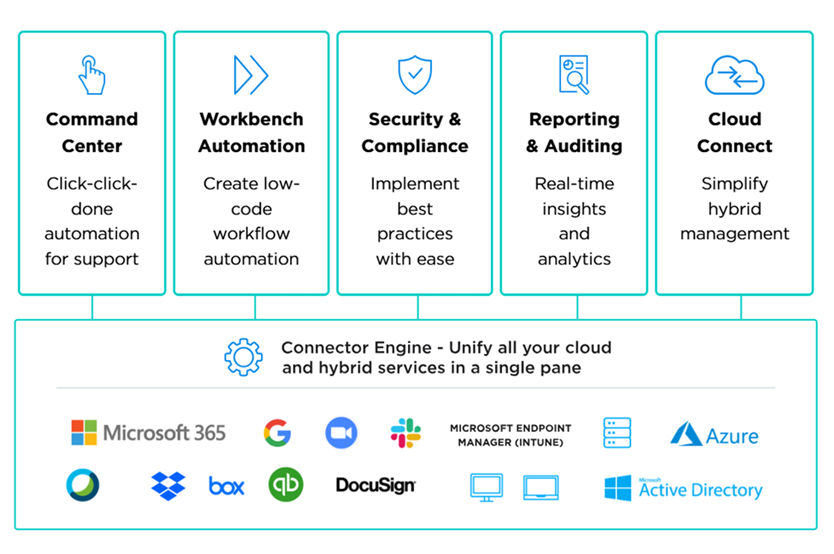As businesses expand their use of software-as-a-service (SaaS) applications, securing and managing these environments becomes increasingly complex. For managed service provider (MSP) professionals, this challenge is even greater due to the number of customers they support, making automation a crucial component of effective cybersecurity management.
Cloud automation is a set of key features that extend the power of ConnectWise SaaS Security™ to centralize control, enforce policies, and protect critical data. Beyond security, this add-on also extends the reach of the base application, enabling the automation of nearly any help desk task, not just those tied to cloud app security.
In this blog, we will explore how cloud automation strengthens SaaS Security and why it’s essential for modern businesses.
What is cloud automation and why does it matter?
Managing cloud services efficiently while keeping costs in check is a common challenge for every MSP. Balancing multiple platforms, ensuring security, and maintaining compliance can stretch even the most experienced teams thin.
However, this SaaS Security add-on offers a solution that turns these challenges into opportunities. By streamlining operations and enhancing security, cloud automation frees up MSPs to focus on growth rather than day-to-day firefighting.
As a centralized platform, cloud automation provides visibility across cloud applications and automates important help desk tasks, such as properly onboarding and offboarding customer employees, all from one interface. With businesses increasingly adopting SaaS solutions, the risk of data breaches and compliance issues grows. Now more than ever, it is essential to properly provision new user accounts with standard security controls and de-provision them to adequately protect company data and prevent unauthorized access from malicious actors.
Cloud automation mitigates these risks by enforcing security best practices when performing everyday tasks, allowing MSPs to operate more securely and efficiently in a cloud-driven world.
With cloud automation, you can:
- Streamline operations and enhance customer experience
Cloud automation helps drive efficiencies by resolving help desk tickets faster, reducing costly escalations, and boosting job satisfaction. By centrally managing cloud services through a single interface, businesses can save more than 10 times the cost of the platform. Additionally, it increases customer satisfaction with up to 75% first-contact resolution and automates license audits.
- Strengthen security and compliance with a cloud-native solution
Secure your business and customer environments with strong cybersecurity layers and role-based controls while gaining visibility across teams, services, and customer apps for data-driven decision-making. Cloud automation also supports modern work practices by offering automation tools that enforce the best practices and security standards.
- Grow your topline with new SaaS offerings
Boost your revenue by offering security-based management services using playbook templates while also expanding your offerings with new Azure services, such as deploying Windows Virtual Desktops. By managing apps, you can diversify your portfolio and provide a profitable full-service MSP experience.
How cloud automation works
Cloud automation is designed around six core areas of technology, enabling you to efficiently manage thousands of tasks across SaaS, PaaS, IaaS, and devices in a fraction of the time. It effortlessly converts PowerShell workflows into automation that’s accessible for general use through an intuitive application, all while being supported by strong security layers, role-based controls, and comprehensive reporting.

Figure 1: How cloud automation works
- Command center: Automate help desk tasks
Traditional IT support often involves navigating multiple portals and performing repetitive tasks. With cloud automation’s command center, MSPs can integrate with Microsoft, Google, Slack, Zoom, and more. This integration helps streamline tasks, reduce escalations, and gain real-time service insight.
- WorkBench: PowerShell automation made simple
While PowerShell can be powerful, its complexity often requires deep scripting expertise. WorkBench makes automation accessible by converting scripts into easy-to-use workflows. With over 7,000 cross-SaaS command options and pre-built templates, automation of onboarding, permissions, and license management becomes more manageable even without scripting knowledge.
- Insights and reporting for smarter decisions
Visibility into help desk operations can be challenging. Cloud automation provides real-time, cross-tenant reporting with Power BI integration. This allows MSPs to analyze service activities, automation trends, and customer interactions, all while ensuring audit trails that maintain security and compliance.
- Cloud connect: Simplified hybrid management
Managing hybrid environments can be complex. Cloud automation simplifies this by leveraging the Microsoft IoT hub. MSPs can securely connect on-premises and cloud environments, automate Microsoft Entra ID sync, and significantly reduce the manual tasks involved in hybrid management.
- Connector engine: Unifying multi-tenant services
Cloud automation’s connector engine unifies SaaS, IaaS, and PaaS environments, enabling seamless no-code and low-code automation. This feature enhances the ability to manage multiple cloud services across different platforms, streamlining processes across multi-tenant customer bases.
Unlocking growth with cloud automation
Cloud automation helps MSPs work smarter, reducing time spent on repetitive tasks and allowing greater focus on strategic growth. Streamlining operations and strengthening cybersecurity can deliver more value to your customers while improving efficiency across the board. Instead of just keeping up with cloud complexity, you can take full control—turning challenges into opportunities and ensuring a more scalable, secure future for your business.
















